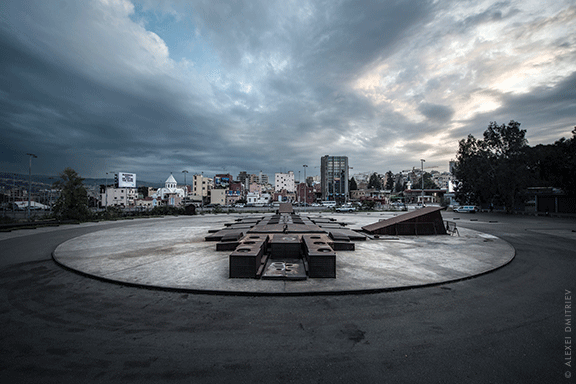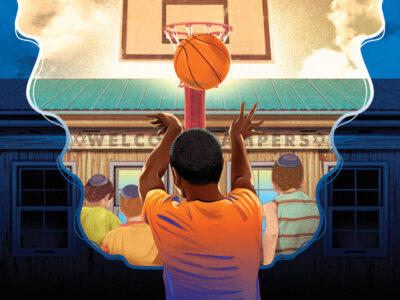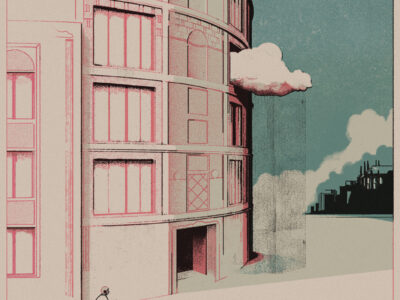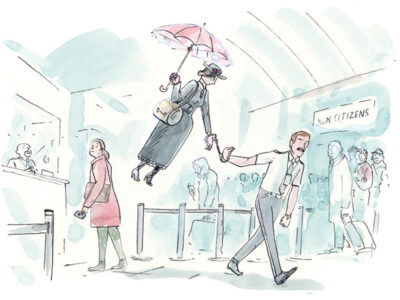
Getting snared by the past in a city that’s trying to forget it.
By Alexei Dmitriev | On the pool terrace of Beirut’s Phoenicia hotel, where well-heeled local families are beginning to trickle in for a sundown movie screening, I am trying—with mixed results—to lounge about. It’s hard to know whether the Emirati tourists, Saudi aristocrats, and European business travelers staying here are finding it any easier to relax. Tonight’s film selection, a Laurel & Hardy feature, has the locals giddy with anticipation. Slapstick comedy goes a long way in politically fragile Lebanon. But the duo’s antics don’t put me at ease.
I’m not the only visitor feeling apprehensive. As I wait for a cab at the hotel entrance, I witness the arrival of a dignitary attended by such a dense enclosure of ferocious-looking bodyguards that just attempting to see his face would end badly for me. Security is taken very seriously in Beirut. Before cars are even searched at the Phoenicia compound’s entrance, they are first scanned for explosives at a safe distance with a sensing device. In 2005, about 400 yards from where I am standing, two tons of TNT ended the life of prime minister Rafic Hariri along with 21 others in his motorcade. Glass would have rained down heavily from all nine floors of the newly re-opened Phoenicia.
Drawing on its reputation for French-flavored cosmopolitanism and liberal attitudes uncommon in the Middle East, Beirut is making a comeback as a playground destination. You can drown in cocktails, or float in tides of low-cut dresses. For the moment Hezbollah, whose popularity in Lebanon keeps growing, is looking the other way. On Rue Weygand in the rebuilt Beirut Central District, luxury-brand boutiques are packed with shoppers and outdoor restaurants have waiting lists. Perfectly restored streets are full of perfect people—the Lebanese swear by cosmetic surgery, and banks offer loans to cover the surgeon’s bills.
Since traffic is bad and explosions are still a part of life, you can also order in: anything from tanning service to McDonald’s home delivery—the only place in the world where it is possible, I am told. I am reminded that I am in a Muslim country when the call for Isha prayer sounds out over my early drink in the retro Dragonfly bar in the hip Gemmayzeh quarter. Five minutes later I hear church bells—a reminder that Lebanon remains a multi-confessional place. Stopping by the St. George Maronite Cathedral during a service in Arabic, I realize that the Christian God is called Allah here. The Al-Amin mosque is fewer than 50 yards away. An Armenian church is another 300. People of different creeds and ethnicities have been living here together for many, many years.
The Lebanese have mastered a rhythm that blends Eastern languor with intense Western socializing. One quickly gets used to encountering seemingly unconnected people who turn out to know each other. There is a charming propensity to show off—making cigars the second most popular status symbol after silicone. There is a perceptible interest among the young in what’s happening in the rest of the world and touchy nostalgia for the French among the old. Beirut is eager to see and be seen.
Yet efforts to promote it as “the Switzerland of the Middle East” gloss over an edge that Switzerland is very happy to do without.
Across the street from the rebuilt Phoenicia is the storied St. Georges Hotel. In its 1960s heyday it hosted stars like Brigitte Bardot and Marcello Mastroianni, but it was never restored to the grandeur that was destroyed by Lebanon’s 1975-90 civil war. In a stroke of irony, the war-torn St. Georges—whose façade was further ruined by the explosion that assassinated Rafic Hariri—now doubles as an emblem of peacetime discontents. The hotel’s owner has plastered it with a giant banner reading “Stop SOLIDERE,” protesting Hariri’s surviving private company, the driving force behind the postwar rebuilding—and controversial rebranding—of the Beirut Central District. SOLIDERE appropriated the St. Georges’ waterfront to build a modern marina filled with glitzy mega-yachts, thereby destroying the hotel’s iconic beach.
There was actually a six-month period during the beginning of the civil war, in 1975-76, known as the Battle of the Hotels. Different factions of Christian militia and the PLO/Mirabitoun alliance clashed at the Phoenicia, St. Georges, and a nearby Holiday Inn. The latter emerged as a favorite snipers’ nest on account of its 26 floors, and it switched hands more than once.
“The rotating rooftop restaurant was considered very high-end, and my dad took my mom there on a date,” a security guard tells me with a chuckle, before putting a damper on my notion of ascending to an ocean-view suite. “It took him a shitload of ammo to make it to the top the next time he wanted to get on the roof.”
So the swanky Phoenicia, along with a spate of new condos in this posh area of the city, is overhung by the Holiday Inn’s dark, bullet-riddled hulk standing like a giant memorial to the 150,000 casualties of the civil war.
In the eyes of many visitors—and I am no exception—Beirut’s image is inseparable from its tragic past. The local mindset seems to oscillate between an official historic amnesia and a Mediterranean machismo that almost turns boastful about the Lebanese perseverance in the face of adversity. Stoicism and bravado. On the main highway leading north to Tripoli, where street fighting between the Lebanese Army and Jabhat-al Nusra, an offspring of ISIS, would erupt a few months after my stay, I gaped at a billboard depicting a model sitting astride a tank cannon, provocatively smiling to motorists. In Gemmayzeh, an old neighborhood suggesting a smaller and warmer Greenwich Village, the Plan BEY gallery was offering collages of photos and other renderings of the civil war.
The new generation sees the war as an aesthetic phenomenon and makes it a subject of art installations and performances. Until recently avant-garde rave parties were thrown in the half-ruined spherical cinema known as “the egg.” While I was there, the “in” place for late-night entertainment was on the rails of the abandoned Mar Mikhael train depot. Past tragedies and proximity to present danger—the war in Syria may spill over at any time—have made the Lebanese experts in living in the moment. Partying with abandon is both a matter of national pride and a selling point for the National Tourism Organization.
“Here we are,” says the cab driver, stopping in a parking lot with no structure in sight.
“Where is the club?” I ask, suspecting trickery on his part. It’s four in the morning and we are in the Karantina neighborhood near the port, where in the old days sailors from arriving ships were kept in quarantine. In living memory, this was the location of a Palestinian-Kurdish refugee camp where hundreds were slain in a 1976 raid by Phalangists.
“Just take the stairs down,” he answers, pointing to what look like big metal plates in the middle of the lot, “and enjoy.”
A pair of bouncers confirm that I have indeed arrived at B-018, one of the top night clubs in the Middle East.
The idea to put a night club in Karantina belongs to Naji Gebran, who during the war opened his house to strangers to let them forget the awful reality outside by listening to music. Gebran’s cousin, the architect Bernard Khoury, modeled this club after a bomb shelter, or perhaps a burial chamber. He calls it “a reaction to difficult and explosive conditions that are inherent to the history of its location—and the contradictions that are implied by the implementation of an entertainment program on such a site.”
The entertainment is thriving. Seeing its own reflection in the mirrored ceiling, the dancing crowd was flirting with the verge of ecstasy. And when it seemed that the sweaty revelers were about to collapse from exhaustion and lack of oxygen, hydraulic machinery retracted the roof, reviving the underground hedonists’ energy with a blast of springtime night air and views of a stellar sky.
It is hard not to wonder what made the hospitable and life-loving Lebanese massacre their neighbors with such ferocity, transforming Beirut into a scene of one of the bloodiest conflicts of the 20th century. Contrary to the prevailing opinion, it was not a clash just between the Maronite Christians and Muslims. Groups within the same faith often slaughtered each other brutally. “It was a perfidious war,” a former field commander named Ellie tells me. “When it was over there was not a group that had not betrayed its friends by allying with enemies.”
Erasing that memory must have been Rafic Hariri’s goal when, in 1994, he began transforming the downtown ruins into the new Beirut Central District. As an urban reconstruction project encompassing a whopping 472 acres, the accomplishments of SOLIDERE certainly merit praise. But there is a sterility to the spotless green streets, lined with replicas of 1920s ochre sandstone buildings. Apartments in them are beyond the means of the butchers, carpenters, and small traders who once created the atmosphere that made Old Beirut such a special place. In place of the old souk’s hubbub came the quiet luxury of the new souk that replaced it in 2009, targeting the fat wallets of Saudis and the Emiratis with luxury brands, and turning the erstwhile “Paris of the Middle East” into a “Dubai of the Levant.”
After a 10-minute walk from the Central District up Beshara Al Khoury street—the infamous former Green Line that divided Muslim West Beirut from Christian East Beirut, along which the fiercest fighting occurred—I enter the area beyond SOLIDERE’s jurisdiction. Here, buildings still show bullet and shell scars. In some of them, the lower floors have been hastily fixed and occupied, while the bombed-out and burned-out top ones have been long inhabited by wind and sorrow. I climb a stairwell with missing walls and walk through gaping holes from one apartment into the next, maneuvering past household belongings picked over by looters long ago.
Here, far from the Phoenicia, there is no escape from the realization that peace accords alone are powerless to heal a civil war’s scars. When Lebanon’s war ended in 1990 and amnesty was declared, the former adversaries did not have the luxury of retreating to separate territories. They continued to live side by side. Every day they risk running into kidnappers of their children at a supermarket, or into their parents’ killers at the gas pump. And even for an outsider, that reality has a grim endurance that overpowers the shiny new city life that has sprung up to distract the mind.
Alexei Dmitriev G’88 is a documentary filmmaker in Potomac, Maryland.





Fascinating. Thanks for the insights, Alexei. Nice story.